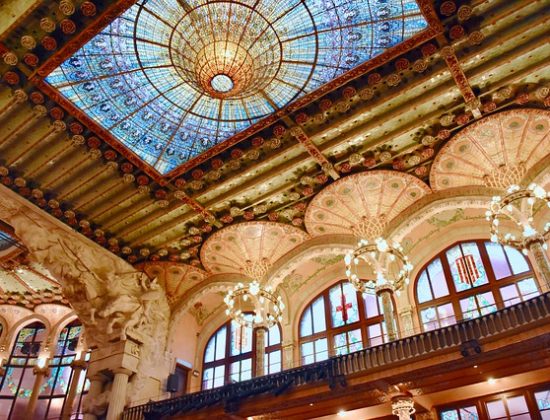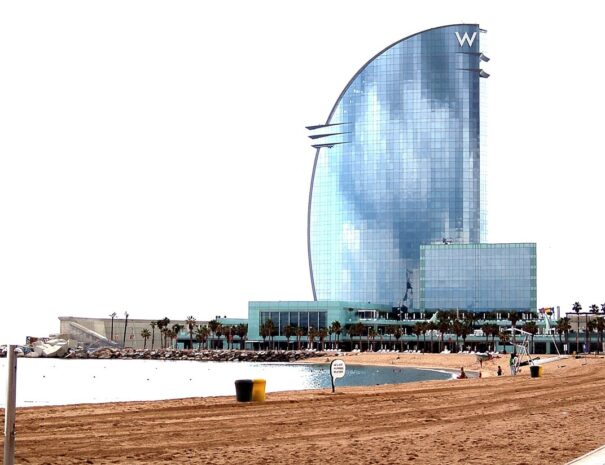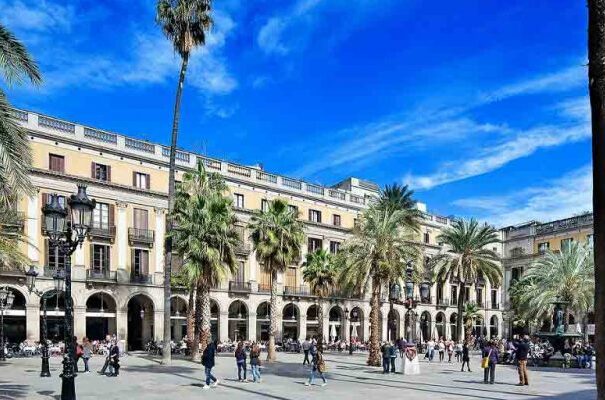Palau de la Música Catalana
- ATTRACTION
- Barcelona
Barcelona music hall - Visitor´s Guide
Located in the El Born neighborhood of Barcelona, the Palau de la Música Catalana is a famous concert hall renowned for its spectacular interior, in particular for its amazing stained glass windows.
The Palau is one of several of Barcelona’s landmarks from the modernist artistic movement. This turn-of-the-century gem, although well-known by locals, is perhaps one of the most overlooked masterpieces in the city by visitors.
Palau de la Música Catalana

History
Catalan Modernism was an architectural and artistic movement that developed at the end of the XIX century in the region. This spectacular concert hall was built at the height of this movement in Barcelona and is a perfect example of this artistic movement with fluid forms and a preference for curves over straight lines.
The highlight is clearly the colorful stained-glass windows, mosaics, and elaborate decoration characterized by rich in natural and figurative themes.
The most famous modernist artist/ architect in Barcelona was Antoni Gaudí, the genius behind some of the city’s most famous buildings and monuments. He designed the Sagrada Família, the Casa Batlló, Casa Mila, La Pedrera, and the Park Güell.
The Palau de la Música Catalana, however, was actually designed by another pioneer of the modernist style, Lluís Domènech i Montaner, who also designed the Hospital de Sant Pau, a modernist hospital building that operated until 2009.
The concert hall took 4 years to complete (between 1905 and 1908) at the behest of the Orféo society. It quickly became the premier concert hall in the city hosting a number of premières by leading artists at the time, such as poet and composer Enric Granados.
The Palau de la Música is still open to the public and hosts regular performances by leading musicians from across the globe. The mission of the Fundació Orfeó Català-Palau de la Música Catalana is to promote music, with special attention to choral singing, knowledge, and dissemination of Catalán cultural heritage.

The period in which the concert hall was built also coincided with the Catalan Renaixença, a period of rebirth for Catalan pride and heritage. Wealthy locals in particular took an interest in the newly built concert hall and made generous donations to support it.
As a result of these donations and the agenda of the donors themselves, the concert hall is now filled with details that commemorate Catalan culture and identity through its choice of techniques, materials, and symbolism.
It’s also the only European concert hall to be illuminated only by natural light. The impressive stained-glass ceiling and the way it is designed allows the Palau de la Música to use only natural light to illuminate the main concert hall during the day.
The stained-glass skylight is built as an inverted dome and uses colors suggestive of the sky and sun with a plethora of blues and golden tones. For concerts held at night, Palau uses and an amazing array of splendid chandeliers and other ornate lighting elements.
The building was declared a UNESCO World Heritage site in 1997 as an example of the Catalan modernist movement that in 1997 along with the Hospital de Sant Pau.
The facade of the Palau is a tribute to classical music featuring the busts of the great composers Johann Sebastian Bach, Giovanni Pierluigi da Palestrina, Ludwig van Beethoven and Richard Wagner.
The Palau de la Musica Catalana, as the name would indicate ( the palace of Catalan music in English) is devoted to promoting Catalán artists, but it has also hosted world-caliber musicians of the likes of Ella Fitzgerald, Paco de Lucía, Norah Jones, Charles Aznavour, Julian Lloyd Webber, Claudio Arrau, Jacques Thibaud, Vladimir Ashkenazy, and Jessye Norman.
How to visit El Palau de La Musica Catalana
You can always go and enjoy a concert if there is an act in town that tickles your interest, but you can also tour the concert hall if there are no concerts programmed.
You can either enjoy a non guided tour with an audio guide, which costs 10€ or a guided tour of the premises for 20€. The guided tour is of course a better option to get all the insider facts and details on The Palau, but if you prefer the audio guide and to explore freely, that is a fine option as well.
The visit, guided or unguided, takes around 50 minutes and when you are done you can enjoy a nice cup of coffee at the venue’s coffee house.
Where to eat at the Palau de la Música Catalana?
The Palau, actually features some very decent eating options on the premises. Whether you want breakfast, lunch, or just a drink after a concert or just because you are in the area, The Palau has something for you.
The Daily menu comes out to 12€per person, which is very affordable, so if you don’t have another restaurant you have your heart set on to eat at after your visit, eating at The Palau is a fine option.
Palau Cafe
Located in the foyer of the Palau de la Música Catalana, this modern cafe-restaurant offers modernized versions of a series of Catalonian classics. Made with fresh local products, the Palau Café offers breakfast service, an excellent daily menu, and a very varied menu with different dietary options.
The terrace of the Palau
Café Palau also has an excellent terrace in the Plaza del Palau, if you want to enjoy your meal or drink al fresco.
El Mirador
Conceived for special meetings and or private groups, El Mirador del Palau, is a very cozy and exclusive space located in the upper part of the Plaza del Palau, facing the façade. It enjoys the best views of any of the dining options at the Palau and the best service and food. Not exactly an option for small groups, but worth mentioning non the less.
Where is The Palau de la Música Catalana?
El Palau de la Música Catalana is located in the classy, up-class Born neighborhood, in the center of Barcelona, within walking distance from Plaza Cataluña. El Born is a trendy neighborhood that stands out because of its winding, medieval streets. During the day, you can enjoy cafes and designer boutiques, while cocktail bars and lounges are the stars of the bubbling nightlife you will find in the Born quarter.
Video tour of El Palau de la Música Catalana
More interesting things in Barcelona

La Barceloneta
Check out our full guide to La Barceloneta, Barcelona’s famous urban beach. There are a ton of tourist traps, and here you find how to avoid them. … Read More

Gothic Quarter of Barcelona
Check out our full guide to The Gothic Quarter of Barcelona, one of the most beautiful and historic areas of the city. … Read More

Port Aventura
Check out our full guide to Port Aventura one of the premier amusement parks in all of Spain, and a great place to visit if you have kids. … Read More

Estadio Camp Nou – Barcelona
Check out our full guide to the Camp Nou, the legendary soccer stadium, home of Barcelona FC, one of the best clubs in Europe of all time. … Read More
